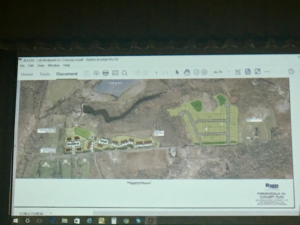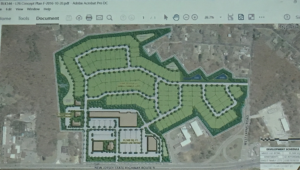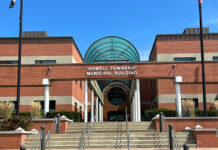
HOWELL – A special township meeting explained the evolution of affordable housing requirements, and what the future of Howell could look with more of it.
The township is awaiting a decision on how much affordable housing it could be required to have, which could mean planning for 322 to 550 units. Where that housing would go, and potential maps, were shown throughout the special meeting.
Many Howell residents attended the special affordable housing meeting to discuss the township’s role in building income-based housing. Residents also viewed concepts from developers showing what the housing might look like and where in town it would be built.
Mayor Theresa Berger told residents that the meeting was being held because while she was campaigning, she heard their concerns about development and affordable housing.
The three-hour meeting kicked off with a history lesson of sorts, as township affordable housing attorney Andrew Bayer, Esq., gave the packed Middle School South cafeteria some background on how affordable housing requirements have evolved over the past 40 years.

In 1975, the Mount Laurel Doctrine ruled that every town in New Jersey had a constitutional obligation to provide its fair share of affordable housing. Ten years later, the Fair Housing Act put that obligation into law and the Coalition On Affordable Housing (COAH) was born, which Bayer referred to as the most hated agency in the state.
COAH gives townships two options: voluntarily participate in state regulations so the town can decide where affordable housing is built, or elect not to participate and be subject to builders’ remedy, meaning builders can sue if they feel a township isn’t following its legal obligation.
Adding more flames to the fire is the fact that COAH failed to issue new affordable housing obligations in 2015. Earlier this year, the Supreme Court ruled that townships have a “gap” responsibility to covers the timeframe that COAH failed to act, from 1999 to 2015. If it weren’t for this curveball, Howell’s preliminary obligation was already set at 368 units.
The township is currently waiting on the Supreme Court to determine what that gap obligation is. Until then, officials said the worst-case scenario would be a 1000-unit obligation, due to a cap in the law.
Based on the housing credits Howell has already received and put into place, officials anticipate planning for 550 affordable housing units. If the obligation is closer to 700 units, which they say is more realistic, it would mean planning for 322 units.
So far, planning officials have met with 16 developers and asked them to provide preliminary concepts of their building plans. Most plans are inclusionary, meaning only a percentage of the proposed development is set aside as affordable housing, typically 15 to 25 percent.
The highest set aside is 27.3 percent, which is a 139-unit mix of 63 single family homes, 35 town homes and 38 affordable apartments on the north side of Birdsall Road. Only three plans offer 100 percent affordable housing.

Township director of community development Jim Herrman stressed that the concepts shown to residents at the meeting are just proposals and no action has been taken to move forward with any of the projects. He also pointed out that the 100 percent affordable housing projects are a better bang for the township’s buck, since they would help meet COAH requirements with the least amount of development.
There was a common denominator during the public hearing portion of the meeting—Ramtown. Many of the citizens who elected to speak were from this densely packed southern portion of Howell, and painted pictures of speeding cars, out of control traffic and overcrowded schools. Out of the 16 properties, Ramtown has the lowest number of projects, but citizens feel that the area has seen enough development and should be spared.
A teenager from Howell High School was brave enough to approach the microphone, pointing out to officials that where these homes are built will affect his and other kids’ futures. He said his school is overpopulated as it is and that it’s difficult to walk through the halls without constantly bumping shoulders with his fellow students. Next year he starts learning to drive and said there will be so many cars on the road, he won’t even feel safe.
Officials hope to turn the map used during the presentation into a PDF and post it on the township website to promote transparency.






